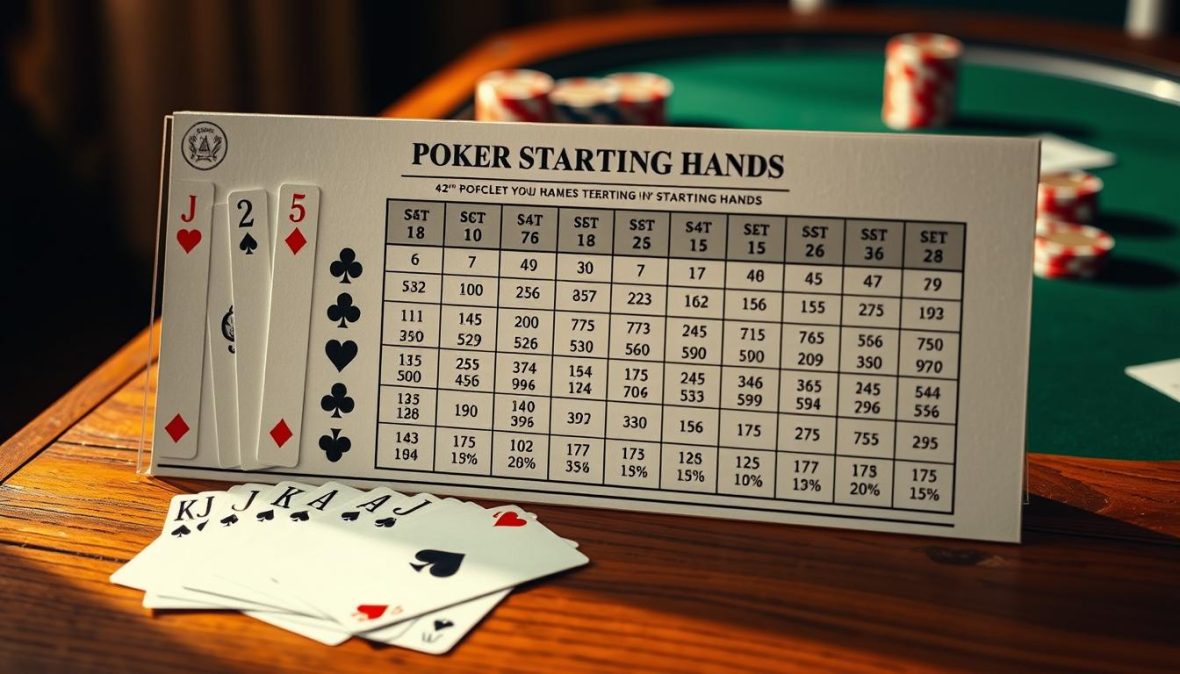Understanding Poker Hand Combinations and Starting Hands

Texas Hold’em poker has 1,326 possible starting hands. This fact changed my view of the game forever. Mastering these math basics sets apart casual players from consistent winners.
TL;DR: There are exactly 1,326 possible starting hands in Texas Hold’em poker. Understanding the mathematical probability behind these hands provides a strategic advantage. Starting hands fall into three main categories: suited (78 combinations), offsuit (1,170 combinations), and pocket pairs (78 combinations). Professional players use probability-based selection methods rather than intuition alone.
The Mathematics Behind Poker Hand Combinations
Understanding poker hand math changed my game approach. It revealed a mathematical ecosystem with predictable patterns. This knowledge gives players a significant edge, regardless of experience.
Basic Probability Concepts in Poker
Poker probability starts with the sample space—all possible outcomes from a 52-card deck. In Hold’em, we calculate how many ways we can get 2 cards from 52.
This is a combination problem. The formula C(52,2) gives us 1,326 possible starting hand combinations. This number is our foundation for preflop calculations.
How Combinations Affect Strategy
Understanding these distributions changes hand selection. Suited hands occur 1/4 as often as offsuit ones. This explains why suited cards are so valuable.
Card combinations influence optimal strategy. Against a tight player who raises preflop, you can narrow their hand range. They’ll have premium pairs less often than strong unpaired hands.
Offsuit Hand Combinations, Pocket Card Combinations, and Suited Hand Combinations
Mastering three types of hand combinations is key to a winning poker strategy:
| Hand Type | Number of Combinations | Percentage | Example | Strategic Value |
|---|---|---|---|---|
| Offsuit Hands | 1,170 | 88.2% | A♠K♦ | Highly variable |
| Pocket Pairs | 78 | 5.9% | J♥J♣ | Immediate strength |
| Suited Hands | 78 | 5.9% | 10♥8♥ | Drawing potential |
Calculating Preflop Starting Hand Odds
Understanding poker hand statistics changed my game completely. Here’s a breakdown of key hand frequencies:
| Hand Type | Combinations | Frequency | Odds |
|---|---|---|---|
| Pocket Pairs | 78 | 5.9% | 1 in 17 |
| Suited Connectors | 36 | 2.7% | 1 in 37 |
| Premium Hands (AA-QQ, AK) | 34 | 2.6% | 1 in 39 |
| Suited Broadway | 60 | 4.5% | 1 in 22 |
Hand Ranges and Position-Based Strategy
Position in poker is a powerful force. It can make or break your starting hands. Understanding this can help you avoid common pitfalls:
- Early Position: Play only 10-15% of hands, including premium pairs (TT+) and strong Broadway cards (AQ+, KQ).
- Middle Position: Play 15-20% of hands, including early position range plus medium pairs and suited connectors.
- Late Position: Play 30-50% of hands, including small pairs and weaker offsuit Broadway combinations.
Advanced Concepts in Hand Selection
Advanced poker concepts can transform your game from break-even to consistently profitable:
- Gap Concept Theory: You need a stronger hand to call a raise than to make it yourself.
- Suited Connector Value: These hands shine in deep-stacked play against opponents who overvalue top pair hands.
- Unpaired High Card Combinations: Hands like KQ, AJ, and KT make up about 192 combinations of premium unpaired hands.
Modern Tools for Hand Combination Analysis
Modern analytical tools have revolutionized poker analysis:
- Poker Odds Calculators: Tools like PokerStove and Equilab provide quick probability calculations.
- Hand Range Visualizers: Programs like Flopzilla improve understanding of range interactions with board textures.
- Solver Software: GTO+ and PioSOLVER explore optimal frequencies and exploitation opportunities.
Conclusion: Mastering Hand Combinations for Better Play
Understanding the 1,326 possible starting hands creates a solid foundation for strategic play. This knowledge is practical ammunition for every decision you make. Start by focusing on simplified ranges, then gradually expand your understanding. Practice with premium hands first, then slowly add suited connectors and gapped hands to your strategy.
Your poker journey is just beginning with this stronger mathematical foundation. Practice these tools regularly and watch as your decision-making improves with each hand you play.
FAQ
How many possible starting hand combinations are there in Texas Hold’em?
Texas Hold’em has 1,326 possible starting hand combinations. This includes 78 suited hands, 78 pocket pairs, and 1,170 offsuit hands. The formula for this is (52 × 51) ÷ 2 = 1,326.
What’s the probability of being dealt pocket aces?
The odds of getting pocket aces are about 0.45% or 1 in 221 hands. There are 6 possible aces combinations out of 1,326 starting hands. This makes them rare but very strong.
What’s the difference between suited and offsuit hand combinations?
Suited hands have two cards of the same suit, like A♥K♥. Offsuit hands have cards of different suits, like A♥K♦. Any two card ranks have 4 suited and 12 offsuit combinations. Suited hands usually have higher equity because they can make flushes.
How do hand combinations affect position-based strategy?
Position greatly impacts which hands you should play. In early position, play fewer combinations, mainly premium hands. You’ll act first post-flop here. In middle position, you can add more strong hands. Late position allows for more profitable hand combinations. You’ll have the advantage of acting last.

